
Delphi, formerly also called Pytho (Πυθώ), is the ancient sanctuary that grew rich as the seat of Pythia, the oracle who was consulted about important decisions throughout the ancient classical world. The ancient Greeks considered the centre of the world to be in Delphi, marked by the stone monument known as the omphalos (navel).

Marble is a metamorphic rock composed of recrystallized carbonate minerals, most commonly calcite or dolomite. Marble is typically not foliated, although there are exceptions. In geology, the term marble refers to metamorphosed limestone, but its use in stonemasonry more broadly encompasses unmetamorphosed limestone. Marble is commonly used for sculpture and as a building material.

Sculpture is the branch of the visual arts that operates in three dimensions. It is one of the plastic arts. Durable sculptural processes originally used carving and modelling, in stone, metal, ceramics, wood and other materials but, since Modernism, there has been an almost complete freedom of materials and process. A wide variety of materials may be worked by removal such as carving, assembled by welding or modelling, or moulded or cast.
An omphalos is a religious stone artifact, or baetylus. In Ancient Greek, the word ὀμφᾰλός means "navel". In Greek lore, Zeus sent two eagles across the world to meet at its centre, the "navel" of the world. Among the Ancient Greeks, it was a widespread belief that Delphi was the center of the world. According to the myths regarding the founding of the Delphic Oracle, Zeus, in his attempt to locate the center of the earth, launched two eagles from the two ends of the world, and the eagles, starting simultaneously and flying at equal speed, crossed their paths above the area of Delphi, and so was the place where Zeus placed the stone. Omphalos is also the name of the stone given to Cronus. In the ancient world of the Mediterranean, it was a powerful religious symbol. Omphalos Syndrome refers to the belief that a place of geopolitical power and currency is the most important place in the world.

Ancient Greek architecture came from the Greek-speaking people whose culture flourished on the Greek mainland, the Peloponnese, the Aegean Islands, and in colonies in Anatolia and Italy for a period from about 900 BC until the 1st century AD, with the earliest remaining architectural works dating from around 600 BC.

In Greek mythology, Python was the serpent, sometimes represented as a medieval-style dragon, living at the center of the earth, believed by the ancient Greeks to be at Delphi.

Ladonia is a micronation, proclaimed in 1996 as the result of a years-long court battle between artist Lars Vilks and local authorities over two sculptures. The claimed territory is part of the natural reserve of Kullaberg in southern Sweden.
Omphalos: An Attempt to Untie the Geological Knot is a book by Philip Gosse, written in 1857, in which he argues that the fossil record is not evidence of evolution, but rather that it is an act of creation inevitably made so that the world would appear to be older than it is. The reasoning parallels the reasoning that Gosse chose to explain why Adam had a navel: Though Adam would have had no need of a navel, God gave him one anyway to give him the appearance of having a human ancestry. Thus, the name of the book, Omphalos, which means 'navel' in Greek.
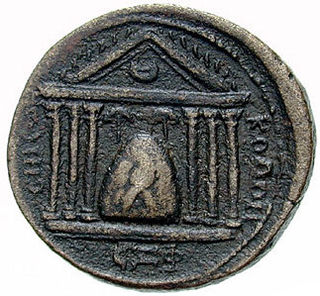
Baetylus are sacred stones that were supposedly endowed with life. According to ancient sources, these objects of worship were meteorites, which were dedicated to the gods or revered as symbols of the gods themselves.
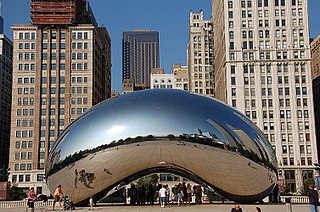
Cloud Gate is a public sculpture by Indian-born British artist Sir Anish Kapoor, that is the centerpiece of AT&T Plaza at Millennium Park in the Loop community area of Chicago, Illinois. The sculpture and AT&T Plaza are located on top of Park Grill, between the Chase Promenade and McCormick Tribune Plaza & Ice Rink. Constructed between 2004 and 2006, the sculpture is nicknamed The Bean because of its shape, a name Kapoor initially disliked, but later grew fond of. Made up of 168 stainless steel plates welded together, its highly polished exterior has no visible seams. It measures 33 by 66 by 42 feet, and weighs 110 short tons.
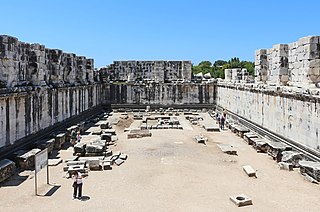
The adyton or adytum (Latin) was a restricted area within the cella of a Greek or Roman temple. The adyton was frequently a small area at the farthest end of the cella from the entrance: at Delphi it measured just 9 by 12 feet. The adyton often would house the cult image of the deity.
Omphalion in Greek means "navel "; compare the omphalos of Delphi.

Architectural sculpture is the use of sculptural techniques by an architect and/or sculptor in the design of a building, bridge, mausoleum or other such project. The sculpture is usually integrated with the structure, but freestanding works that are part of the original design are also considered to be architectural sculpture. The concept overlaps with, or is a subset of, monumental sculpture.
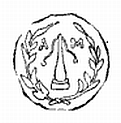
Apollo Agyieus was an epithet of the Greek god Apollo describing him as the protector of the streets, public places, and the entrances to homes. As such he was worshiped at Acharnae, Mycenae, and at Tegea. The origin of the worship of Apollo Agyieus in the last of these places is related by Pausanias.
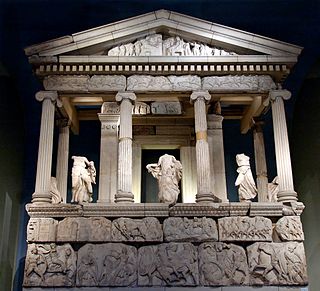
The Nereid Monument is a sculptured tomb from Xanthos in Lycia, close to present-day Fethiye in Mugla Province, Turkey. It took the form of a Greek temple on top of a base decorated with sculpted friezes, and is thought to have been built in the early fourth century BC as a tomb for Arbinas, the Xanthian dynast who ruled western Lycia under the Achaemenid Empire.

Karl Gottlieb Wilhelm Bötticher was a German archaeologist who specialized in architecture.

Dimitri Hadzi was an American abstract sculptor who lived and worked in Cambridge, Massachusetts, and also taught at Harvard University for over a decade.

Ancient Greek art stands out among that of other ancient cultures for its development of naturalistic but idealized depictions of the human body, in which largely nude male figures were generally the focus of innovation. The rate of stylistic development between about 750 and 300 BC was remarkable by ancient standards, and in surviving works is best seen in sculpture. There were important innovations in painting, which have to be essentially reconstructed due to the lack of original survivals of quality, other than the distinct field of painted pottery.

The Omphalos of Delphi is an ancient marble monument that was found at the archaeological site of Delphi, Greece.
Omfalos is a concrete and rock sculpture attributed to the Swedish artist Lars Vilks. It was forcefully removed from a natural reserve area where it had been unlawfully erected, and currently belongs to the collections of the Moderna Museet.















